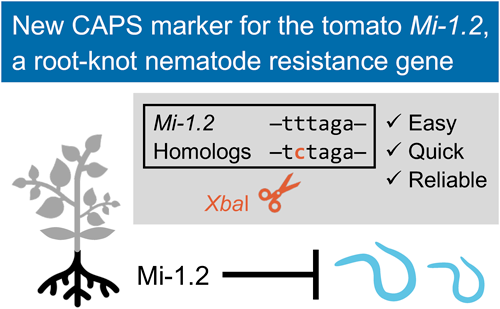4 0 0 0 OA A rapid method for detection of the root-knot nematode resistance gene, Mi-1.2, in tomato cultivars
- 著者
- Chihiro Furumizu Shinichiro Sawa
- 出版者
- Japanese Society for Plant Biotechnology
- 雑誌
- Plant Biotechnology (ISSN:13424580)
- 巻号頁・発行日
- pp.22.1206a, (Released:2023-02-10)
- 参考文献数
- 6
- 被引用文献数
- 1
Molecular markers have been widely used in plant breeding to improve the accuracy and efficiency of trait selection. In particular, molecular markers are powerful in facilitating the introgression of resistance genes by circumventing costly and time-consuming infection assays. To achieve their practical use, it is important to ensure the tight linkage between the markers and the traits. Here we report a new cleaved amplified polymorphic sequence (CAPS) marker, Mi1713, for the root-knot nematode resistance gene, Mi-1.2, in cultivated tomato. The Mi1713 marker is designed in the conserved region of Mi-1.2 and its homologs in tomato and other nightshade species. Combined with a single-step procedure for preparing PCR templates, the Mi1713 marker enables rapid and reliable screening for the presence of Mi-1.2. The approach described in this study is applicable in designing CAPS markers for various genes or alleles of interest in tomato and other crops.
3 0 0 0 OA Database mining of plant peptide homologues
- 著者
- Na Yuan Chihiro Furumizu Baolong Zhang Shinichiro Sawa
- 出版者
- Japanese Society for Plant Biotechnology
- 雑誌
- Plant Biotechnology (ISSN:13424580)
- 巻号頁・発行日
- vol.38, no.1, pp.137-143, 2021-03-25 (Released:2021-03-25)
- 参考文献数
- 37
- 被引用文献数
- 5
In plant-pathogen interactions, pathogens employ secreted molecules, known as effectors to overcome physical barriers, modulate plant immunity, and facilitate colonization. Among these diverse effectors, some are found to mimic the plant peptides, to target host’s peptide receptors, and intervene in the peptide-regulated defense pathways and/or plant development. To better understand how pathogens have co-evolved with their plant hosts in order to improve disease management, we explored the presence of plant peptide mimics in microbes by bioinformatic analysis. In total, 36 novel peptide mimics belong to five plant peptide families were detected in bacterial and fungal kingdoms. Among them, phytosulfokine homologues were widely distributed in 22 phytopathogens and one bacterium, thereby constituted the largest proportion of the identified mimics. The putative functional peptide region is well conserved between plant and microbes, while the existence of a putative signal peptide varies between species. Our findings will increase understanding of plant-pathogen interactions, and provide new ideas for future studies of pathogenic mechanisms and disease management.
